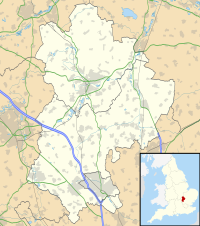Bedford Castle
| Bedford Castle | |
|---|---|
| Bedford, Bedfordshire, England | |

Remaining motte of Bedford Castle
|
|
| Coordinates | 52°08′07″N 0°27′48″W / 52.13539°N 0.46333°W |
| Grid reference | grid reference TL052496 |
| Type | Motte and bailey |
| Site information | |
| Condition | Destroyed, part of motte remains |
| Site history | |
| Materials | Stone |
Bedford Castle was a large medieval castle in Bedford, England. Built after 1100 by Henry I, the castle played a prominent part in both the civil war of the Anarchy and the First Barons' War. The castle was significantly extended in stone, although the final plan of the castle remains uncertain. Henry III of England besieged the castle in 1224 following a disagreement with Falkes de Breauté; the siege lasted eight weeks and involved an army of as many as 2,700 soldiers with equipment drawn from across England. After the surrender of the castle, the king ordered its destruction. Although partially refortified in the 17th century during the English Civil War, the castle remained a ruin until the urban expansion in Bedford during the 19th century, when houses were built across much of the property. Today only part of the motte still stands, forming part of an archaeological park built on the site between 2007 and 2009.
Bedford Castle was probably built after 1100 by Henry I in the town of Bedford, overlooking the River Great Ouse. The castle was constructed inside the town itself, and many of the older Anglo-Saxon streets had to be destroyed and diverted to make room for it, leaving a permanent mark in the formal grid system. The castle was built in a motte and bailey design and was probably much smaller than the later castle, just consisting of the motte and the inner bailey.
By the early 12th century the castle was controlled by the royal castellan, Simon de Beauchamp, the son of Hugh de Beauchamp who had helped conquer England in 1066. Contemporaries described the castle around this time as "completely ramparted around with an immense earthen bank and ditch, girt about with a wall strong and high, strengthened with a strong and unshakeable keep". Simon died in 1137, and King Stephen agreed that Simon's daughter should marry Hugh the Pauper and that the castle would be given to Hugh, in exchange for Stephen giving Miles compensatory honours and gifts. Miles and Payn de Beauchamp, the children of Simon's brother, Robert de Beauchamp, declared that the castle was rightfully Miles' and refused to hand it over to Hugh.
...
Wikipedia

